Petunias are one of the most popular flowering plants. Lush bushes with white, pink, red, purple, and spotted blooms can be found in urban flowerbeds, private gardens, and on city balconies. To prolong flowering and rejuvenate the bushes, gardeners prune petunias in mid-summer.
Table of contents
Why Prune Petunias
Petunias are low-maintenance plants that delight with their abundant blooms. To maintain their beauty, a "trim" is performed in mid-summer. If left unattended, the plant will stretch, and the flowers will become small and dull.
Pruning petunias begins at the seedling stage. The main branches are pinched to stimulate the growth of side stems. Using fingers or scissors, the tips of the stems are removed, making the shoots thicker and the leaves more vibrant. After two weeks, the first buds appear, and dormant buds activate and grow quickly.
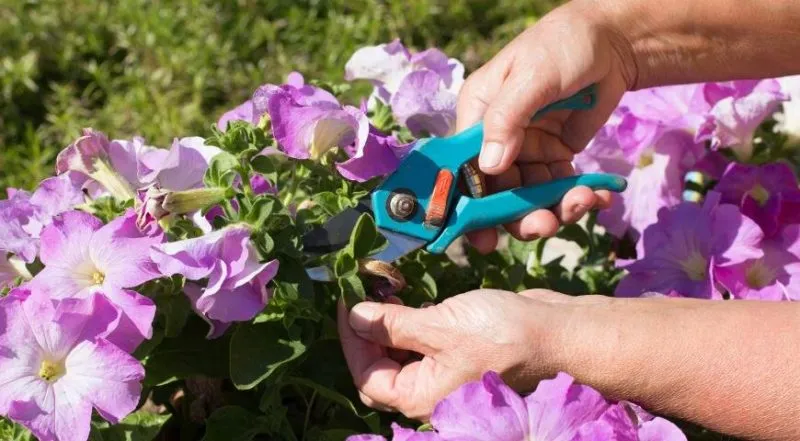
Trimming petunias is an essential procedure to maintain a neat shape. This method helps create unique forms and change the direction of stem growth. You can shape them into a ball or let the branches cascade beautifully.
Important! Shaping petunias is only effective if the stem was pinched timely during the growing season.
Proper pruning helps if stems stretch due to insufficient light or poor care. Bush varieties are trimmed without hesitation, leaving only 15 cm in length, while trailing varieties are pruned as desired. After pruning, the plant regrows vigorously.
Pruning or pinching is only done on mature plants. This stimulates flowering and allows propagation through cuttings. Three to four weeks after the first procedure, side stems are shortened further to add volume. Subsequent trims are done as needed, depending on the plant's condition.
When to Prune
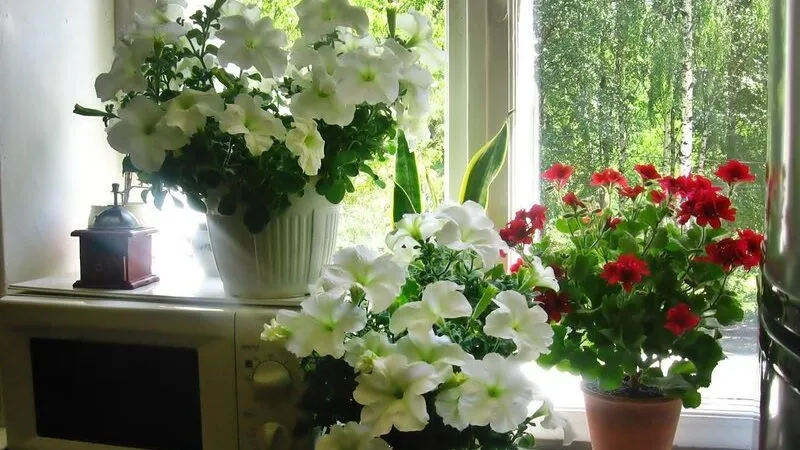
Pruning is straightforward, even for beginners. The timing depends on the plant's growth stage. In early summer, the bushes grow actively, looking healthy and attractive. By late season, without proper care, the plant may dry out, and flowering may stop entirely.
The first pinching is done in early June, after which petunias grow foliage and develop buds. The second pruning occurs in July-August to shape the bushes and stimulate flowering.
Rejuvenating Summer Pruning
In summer, gardeners prune petunias to rejuvenate the plant, enhance its appearance, and encourage blooming.
For Abundant Flowering
How to refresh the plant? By July, petunias bloom less, and the bushes thin out. To stimulate new flowers, pruning is necessary. Use garden shears, scissors, or pinch stems by hand. Ignoring this will make the plant focus on seed production. Trim the central stem and side shoots.
Note. Avoid pinching only the tips, as new branches will grow thin and weak.
Pinch stems where few flowers remain, leaving four leaves on each trimmed stem. Remove dry buds manually or with nail scissors. Experienced gardeners recommend pinching petunias monthly until late September.
For Shaping the Bush
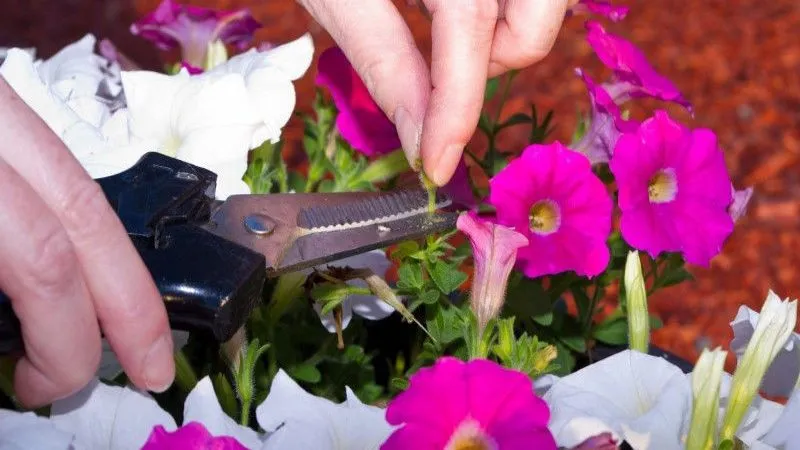
In August, pruning revives the plant and ensures lush flowering. The process is the same as in July.
Due to intense blooming, petunias lose strength quickly. To restore them, bushes are regularly misted and fertilized weekly.
After flowering, pruning is done if the plants are decorative. If seeds are needed, skip pruning. If frequent pinching doesn’t help and leaves yellow, trim bushes by one-third. Remove the plant from the pot with the root ball and split the root system in half with a sharp knife.
After division, replant petunias in larger pots with fresh soil. Keep them in a dark place for a week, watering regularly. For three weeks, fertilize with nitrogen, then switch to complex fertilizers. After this pruning, petunias will bloom again by late August and continue until September.
How to Prune Correctly
How to prune for lush blooms? Follow these guidelines. Use garden shears or secateurs, sterilized with potassium permanganate or medical alcohol.
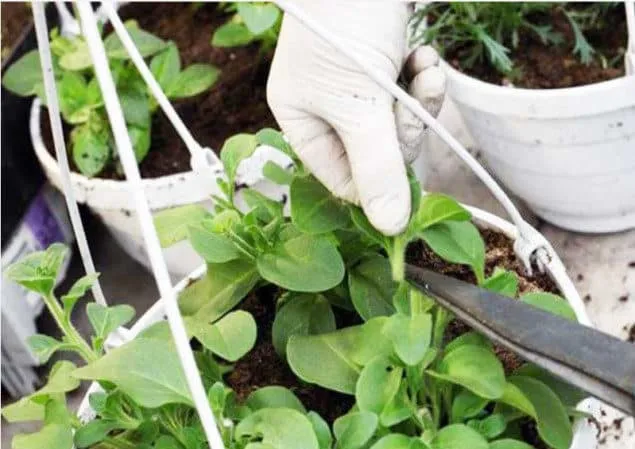
Pruning Rules
To help petunias recover faster, follow these tips:
- Bushes should be strong and healthy, with at least five large leaves per stem.
- Place a container nearby for collecting cuttings.
- Remove 3-4 cm from the top of each stem.
- Prune in the morning or evening when the sun is less intense.
How to Prune Petunias for a Lush Cascade
To achieve a cascading bloom, rejuvenate petunias following general advice. Trailing varieties have delicate, hanging stems trimmed to half their length. Note that if pruned in July, they won’t regrow long tendrils. So, trim trailing types once they lose appeal.
Cascade varieties grow upward. When pruning, leave 15 cm-long shoots. Trimming only the tops encourages width, creating interesting floral shapes.
Important! Prune before fertilizing so the plant gets extra nutrients and blooms abundantly.
Aftercare
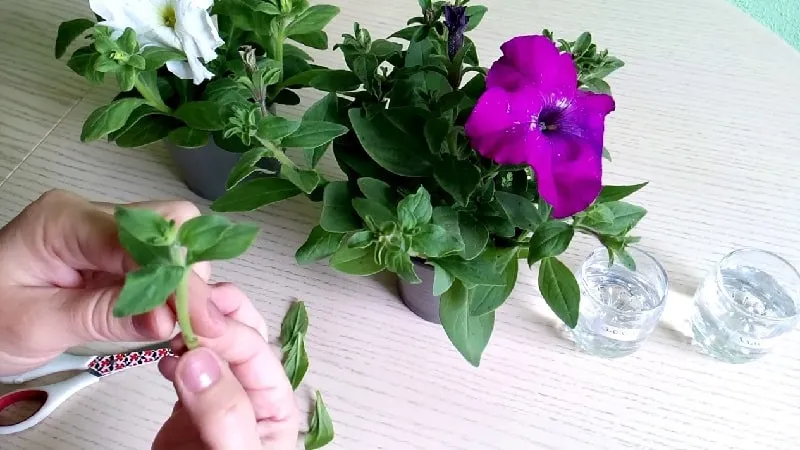
To keep petunias blooming profusely, follow these tips:
- Fertilize with minerals and growth stimulants for vigorous growth.
- Water daily in drought and mist in the evening.
- Remove wilted flowers with their stems.
Fertilization Guidelines:
- After planting, apply 5 tsp of monopotassium phosphate per 10L of water. Weekly, use "Zirkon" (1 ampoule per 10L). For better blooms, use "Compo Flower Fertilizer" with micro- and macronutrients.
- In mid-July, apply "Compo Flower Fertilizer" mixed with monopotassium phosphate and potassium nitrate every five days. For abundant blooms, use urea (10g per 10L). Nitrogen boosts foliage and flowering.
- In August, feed with "Fertika" and monopotassium phosphate weekly.
By late summer, reduce fertilization. By then, the plants will be strong and bloom until season’s end.
Conclusion
Trim stems with dry leaves and spent flowers regularly from June onward. Summer pruning is crucial. The first trim is in June, followed by July-August. Use garden shears, secateurs, or sharp knives.
Pinch stems manually; remove dry flowers with nail scissors. Pruning stresses the plant, so replenish its strength with nitrogen and complex fertilizers. Growth stimulants promote lush blooms and foliage. With proper care, petunias will flourish until late September.







